In our newest report, Clawing at the Cages: Big Cats in Zoos, we explore the numerous welfare and conservation issues of keeping big cats in zoos. We also highlight instances of facilities continuing to exploit big cats in ways that are unsafe to the animals and humans that participate in these interactions, even after the passage of the Big Cat Public Safety Act (BCPSA), a federal bill that was signed into law in the U.S. in 2023 on the grounds of protecting public safety.
Zoos Use Loophole in the Big Cat Public Safety Act to Continue Big Cat Interactive Experiences
The BCPSA bars any member of the public from coming into direct contact with a prohibited big cat species, which refers to all Class 1 cats, including lions, tigers, leopards, snow leopards, jaguars, cougars, or any hybrid of these animals. The passage of the BCPSA affected zoos by banning the use of big cats in photo ops, cub handling opportunities, and feeding experiences in which members of the public had direct contact with the animals. While the act was designed to protect public safety, rather than promote animal welfare, the legislation has provided many resulting benefits to the welfare of animals formerly exploited in this way.
Unfortunately, the BCPSA allowed an exemption for “a trained professional employee or contractor of the entity or facility” to handle these prohibited species. This exemption has resulted in the continued use of big cats in profitable photo ops as some zoos have sought to create ways to continue unethical activities by skirting the boundaries of what is and is not legal. Zoos accomplish this by having only employees handle the animals but continuing to use them (including cubs) in photo ops, using inadequate/unsafe barriers to separate the big cats from the public, and failing to comply with the 15-foot required distance between a big cat and the public if the animal is not in their “permanent” enclosure.
Unfortunately, the BCPSA allowed an exemption for “a trained professional employee or contractor of the entity or facility” to handle these prohibited species. This exemption has resulted in the continued use of big cats in profitable photo ops as some zoos have sought to create ways to continue unethical activities by skirting the boundaries of what is and is not legal.
Big Cat “Close Encounter” Experiences Continue
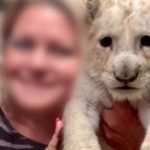
For example, Myrtle Beach Safari in South Carolina regularly offers cub petting experiences to patrons with the use of a malleable, clear barrier. Videos on Myrtle Beach Safari’s Instagram account confirm that photo op experiences involving tiger, white tiger, lion, and hybrid cubs still occur using this strategy. In many of these images, an animal handler holds the cub as the patron presses their hands and/or face against the malleable barrier to get as close as possible to the cub for the photo.
We also collected evidence that confirmed the use of inappropriate barriers and unsafe distances between big cats and spectators at state fairs, private events, and school functions. A photo taken at the 2023 Carver County fair in Minnesota depicts a woman holding a young child while feeding an adult white tiger with a long pole at “Tiger Encounter” event with animal trainer Felicia Frisco. This photo demonstrates an inappropriate barrier and potentially unsafe distance from the tiger; it would only take one forceful tug from the tiger to knock the woman over the precarious barrier, thus putting her and the child in immediate danger.
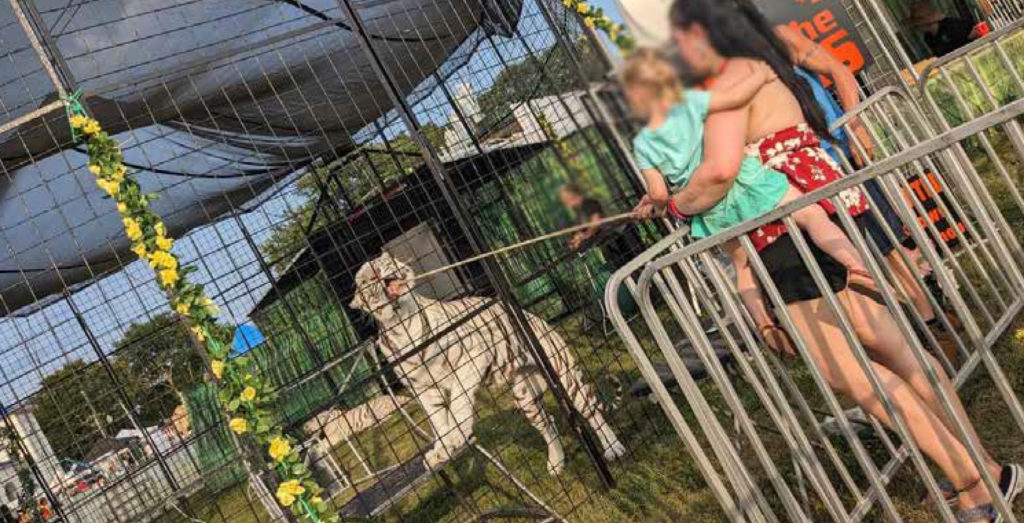
Another photo shows an adult tiger from the company Exotic Animals Miami in a transport cage at a child’s bar mitzvah party in Florida in 2023. One of the children in attendance stands directly in front of the tiger’s cage, with just a flimsy movie theater-style retractable belt barrier between them.
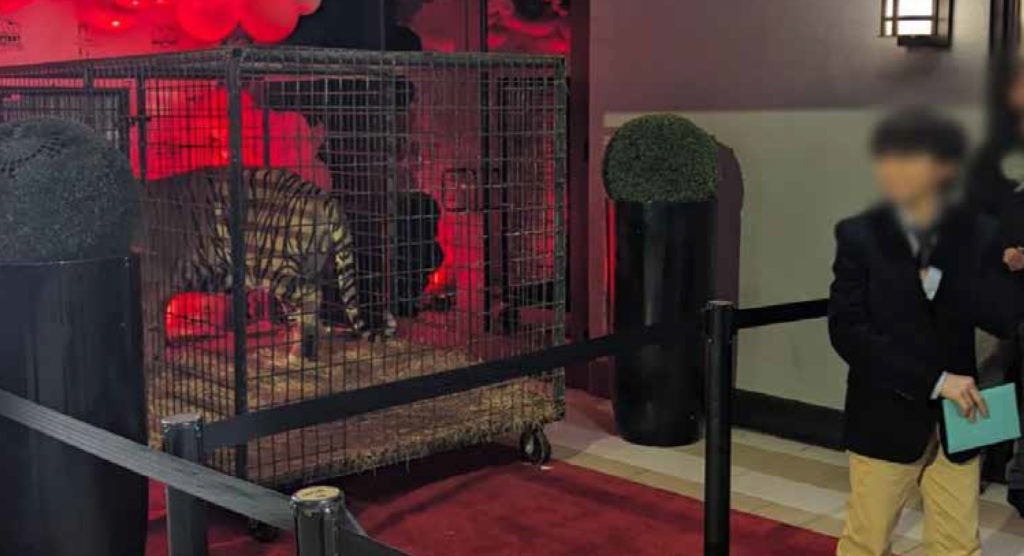
Similarly, an elementary school’s social media page demonstrated a traveling animal encounter experience offered by Kowiachobee Animal Preserve in Naples, Florida in 2023, featuring an adult tiger in a transfer cage, no observable barrier, and potentially unsafe distance between the big cat and the crowd of young children in attendance.
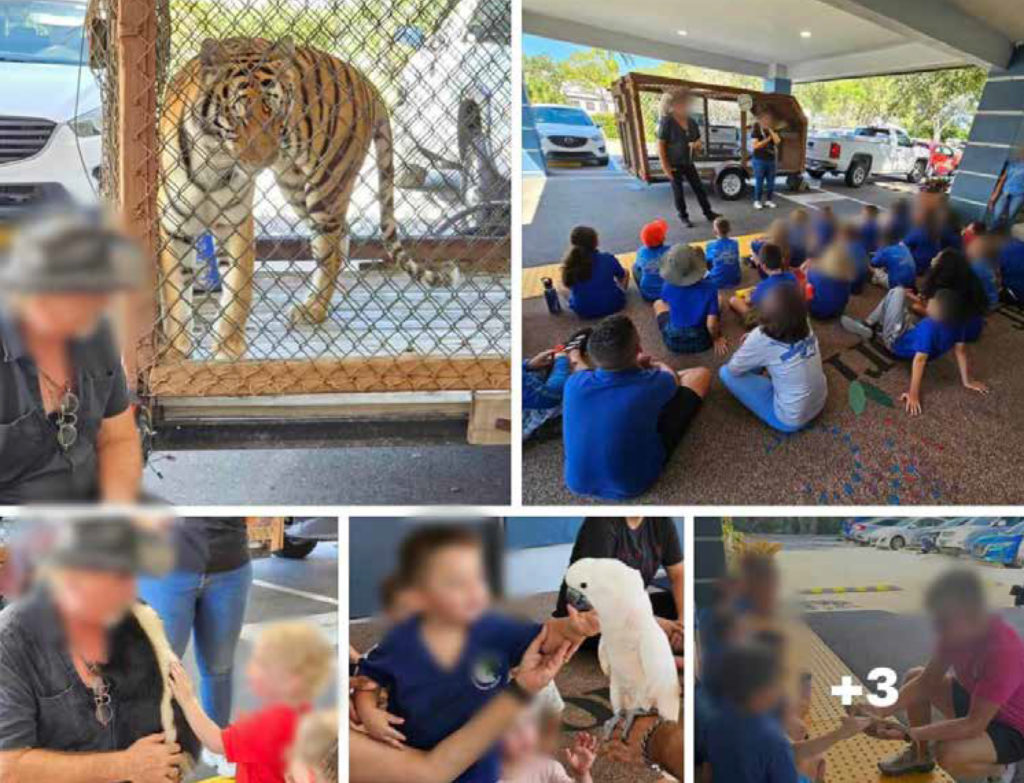
Sadly, Big Cat Habitat & Gulf Coast Sanctuary in Sarasota, Florida was documented exploiting an adult white tiger named “Barry White” in 2023 by confining him to a small transport cage with a glass front and no barrier to provide photo op experiences for patrons. Six years prior, in 2017, a PETA eyewitness documented that “Barry White” had large calluses on his front legs (potentially from living on concrete in his home enclosure) and was sucking his own tail, a type of self-injurious behavior indicative of a high stress level, during the photo op experience.
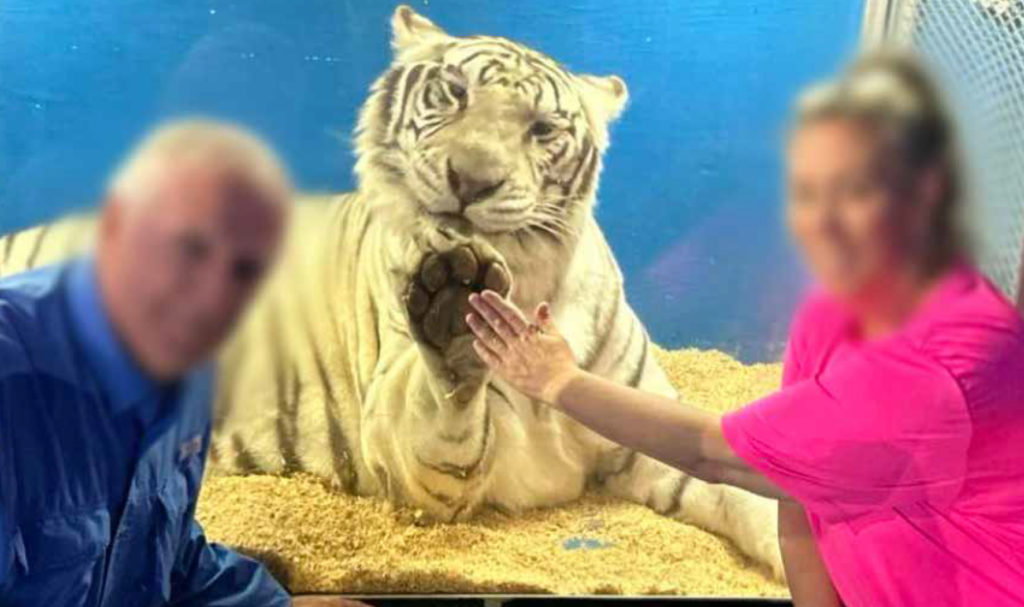
Other Zoos Have Simply Shifted to Offering Interactive Experiences with Smaller Species
Just as problematically, since the introduction of the BCPSA, some facilities have simply switched to, or increased promotion of, the use of other smaller – but still dangerous – species of cats such as cheetahs and servals for these interaction experiences. We must remain conscious of the detrimental effects these interaction experiences have on human safety and the welfare of any wild animal species, irrespective of their size or legal protection status, from big cats to smaller cats, and all animals in between.
Sign the Petition to End Big Cat Interactions!
We call upon the public to stop supporting the zoo industry by not going to venues that keep big cats and offer interaction experiences with them. We have also launched a petition calling on the U.S. Fish and Wildlife Service (USFWS) to expand the monitoring of big cats in captivity and initiate regulation changes as needed in response to these ongoing dangerous practices that we have outlined in our new report, Clawing at the Cages.
Keep Wildlife in the Wild,
Devan
Dear Reader,
We are a nonprofit committed to wildlife conservation, welfare, and rescue. Making resources free and widely distributed, like our news items, is an important part of our mission. If you found this article helpful, enjoyable, or enlightening, please donate to help keep these resources available, and Keep Wildlife In The Wild.
Thank You,
The Born Free USA Team

 Dear Reader,
Dear Reader,